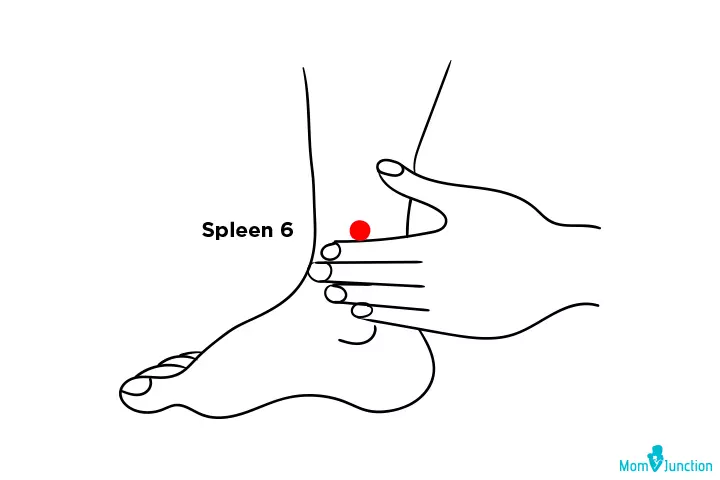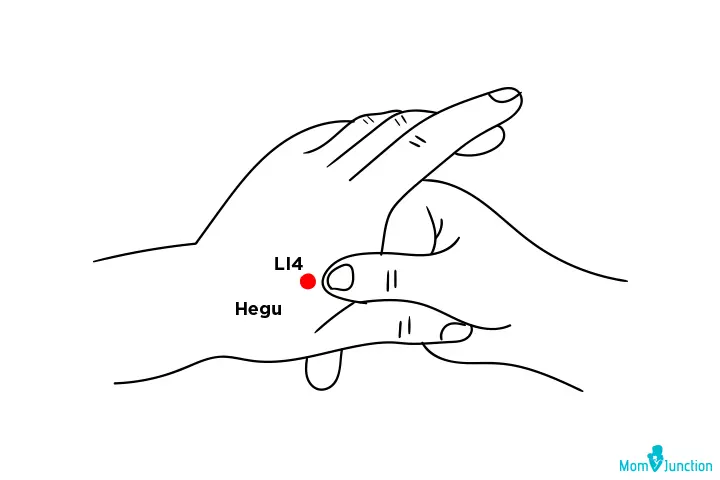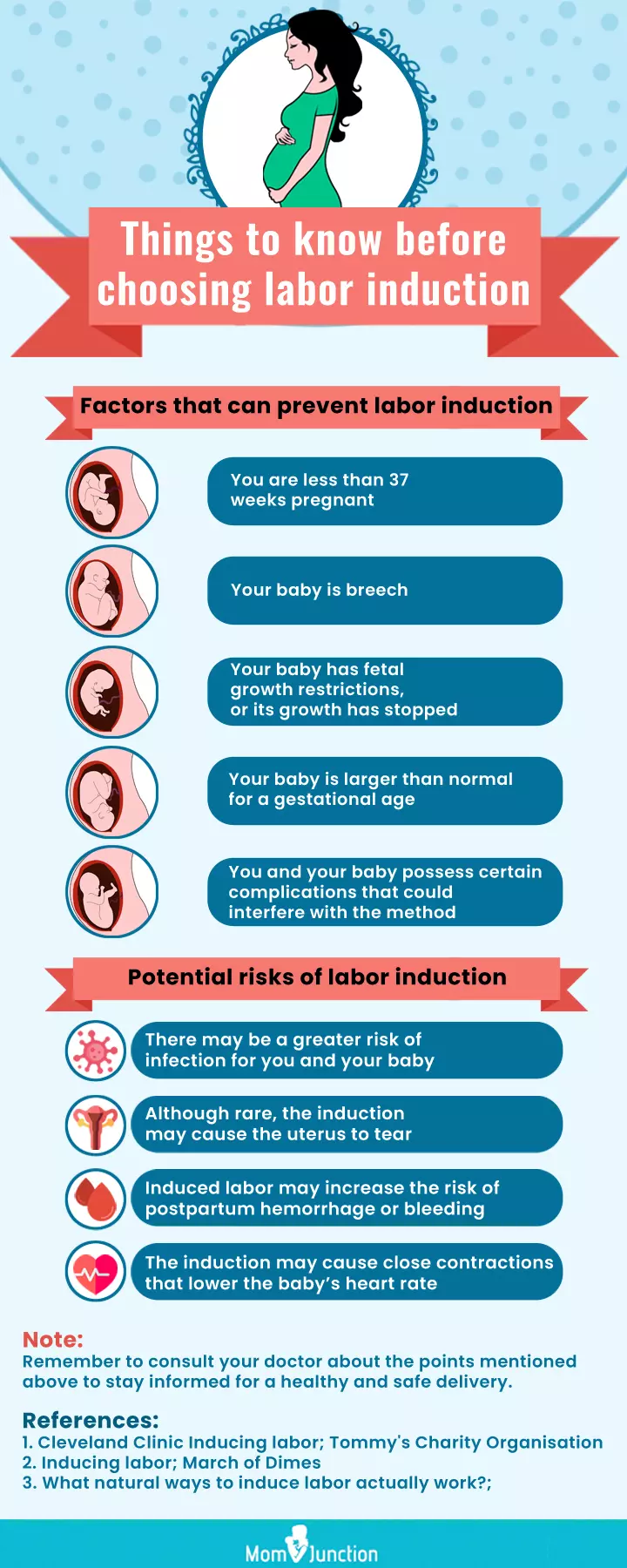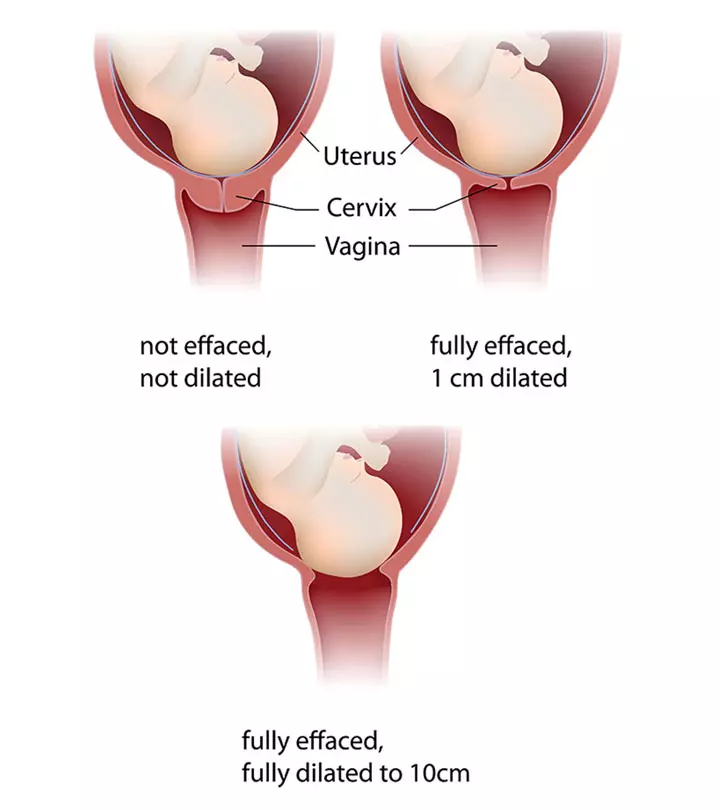
Image: MomJunction Design Team
Most women naturally go into labor when they reach their due date. However, a doctor may need to speed up labor if a mother has passed her due date and still has no labor pains (1). Alternatively, when a mother has medical conditions like obstetric cholestasis (bile acid buildup), pregnancy-induced hypertensioniHigh blood pressure, characterized by consistently elevated force of blood against the walls of arteries. , PUPPP or pruritic urticarial papules and plaques of pregnancy (itchy skin rashes peculiar to appear in late pregnancy) that can affect her or her baby’s health in any way, labor induction becomes necessary. Keep reading as we tell you about the different ways to speed up your labor under medical supervision.
Key Pointers
- Changing positions, walking, and using a birth ball can speed up labor by stimulating the baby’s descent.
- Relaxation techniques like visualization, deep breathing, and massage can reduce tension and hasten labor.
- Nipple stimulation can lead to the production of oxytocin, a hormone that increases contractions and speeds up birth.
- Acupuncture can promote contractions, speed up labor, and increase hormone release by relaxing muscles.
When Would You Ideally Go Into Labor?
You are likely to get labor pains sometimes after 37 weeks as the fetus attains maturity after 37 weeks.
Although pregnant mothers feel tightening of the tummy somewhere after the seventh or eighth month of pregnancy, they are not intense and painful and do not come at regular intervals.
After around 37 weeks or more commonly at 39 or 40 weeks, the pains occur every 20 minutes, which is when you should go to the hospital. It is normal even if labor pains start a few days beyond the estimated delivery date. One can wait even until 42 weeks, but waiting beyond the delivery date would mandate close fetal monitoring with tests called nonstress test (NST) and sonography for the amniotic fluid index (2).
The potential problem of prolonged pregnancy is the placenta may lose its capacity to nourish the baby. When you reach 41 weeks, your doctor may propose the following solutions.
- Medical induction of labor
- Cesarean section (especially if the fetus status is already weak, there is reduced growth, or a lack of amniotic fluid)
- Monitoring the pregnancy (ultrasound scans) every two days till the 42nd week, waiting for the labor to begin naturally
When Do You Need to Initiate or Accelerate Labor?
Labor is induced when the mother has not developed labor pains yet or is in the very early stages of labor and the cervix has not opened or minimally opened (3). Labor needs to be induced if the mother develops certain conditions as mentioned earlier in the post.
According to the US CDC’s National Vital Statistics Reports, 32.1% of mothers underwent labor induction in 2021. It indicates that inducing labor among expecting women isn’t uncommon. Besides inducing labor, some women may need interventions to accelerate labor.
Labor is accelerating when the mother is already in active labor (which means the cervix is already opened). Acceleration of labor is done when the uterine contractions are poor and the cervical dilatation or opening of the cervix is not happening at the expected rate. The expected rate of dilation is around 1.2cm to 1.5cm per hour till it reaches full dilatation, which is 10cm. But if that does not happen and the cervix is dilating slowly, it is considered as slow labor and needs to be accelerated or hastened (4).
 Quick fact
Quick factCan You Initiate or Accelerate Labor Without Medical Assistance?
Yes, it is possible and there are several ways to achieve this. However, it can also be done with medications.
Natural Ways To Speed Up Labor
At-home methods work most of the time, but not always. You can try and see if they will work for you. Some natural methods or home remedies to speed up labor include:
- Change positions: Staying in a single place without much mobility might go against you. You need to change positions or postures for the baby to move into an optimal position for delivery. Moving around or getting into specific postures or positions, like squatting, on all fours, or kneeling, can help the baby descend into the pelvis and apply pressure on the cervix. As you move, the baby adjusts to the best position to progress the labor (6). Hence, positional changes may help speed up the labor.
- Take a walk: When you near your due date, walk frequently and allow gravity to do the work for you. It will also help the baby enter into the correct position for birth as it descends into the pelvic region. Movements such as rocking, swaying, and dancing (known as labor dance) will help decrease the pain too (7).
Jessica Potts, a mother of a baby girl, shares her experience with trying different methods to stimulate natural labor. She writes, “Personally, I’ve been walking every night. On nights when I’m in pain, we walk about a mile, on nights I’m feeling well, we walk up to 4.5 miles. Every walk seems to bring on contractions, but the longer walks seem to do the most (the night we walked 4.5 miles, I had contractions 5 mins apart for 45 mins, but I also managed to injure my foot, so…). So far, walking seems the most effective, yet not enough to bring on labor (ii).”
 Quick fact
Quick fact- Stimulate your breast: This releases oxytocini in the bloodstream which triggers contractions and speeds up labor. You can either massage your nipples using your fingers or use a breast pump (9). A warm shower with water falling and moving down the nipples will also stimulate the breasts.
- Relax in a warm shower: Sit or stand in a warm shower for relaxation. It will ease tension during the cervical dilation and contractions. Also, lying down in a warm bathtub helps, but you should have someone to help you with it (6). Listening to calming music during a spa, or visualizing tranquil places during deep breathing exercises can also be relaxing.
- Acupressure: Applying pressure on specific pressure points will stimulate contractions, and thus speed up the labor. Have someone help you with this technique, or you can get it done by an acupressure specialist. The three primary pressure points to focus on include:
- Spleen-6, located approximately four-finger width above the inner ankle bone (inside of your ankles) (10).

- Large intestine-4, located between the thumb and index finger on the backside of the hand (11).

- Gallbladder-21, located slightly lateral to the spine and lies in the middle of the spinal process (12).

Applying pressure on these pressure points to induce labor will also help subside the pain.
- Have sexual intercourse: If you’re past the due date but labor pains have not yet started, having sexual intercourse can induce labor. Though there is no scientific evidence to support this it releases substances called prostaglandinsiA type of lipid compound that acts as a signaling molecule in the body, affecting inflammation, blood flow, and other processes. and the prostaglandin release initiates labor. In fact, the labor-inducing medicines contain prostaglandins. Also, orgasms release oxytocin, which stimulates contractions (13). Dr. Alan Lindemann, medical doctor from Elgin, North Dakota, says, “Sexual intercourse works by releasing oxytocin, released during orgasm, which causes a contraction. Remember that a uterine contraction produced this way can be unexpectedly painful, although there is no evidence of harm. However, one condition where sexual intercourse would be contraindicated is placenta previa.”
- Consume castor oil: Traditionally castor oil was given to kick start the labor. Mix two ounces of castor oil with equal amounts of orange juice and one teaspoon of baking soda (since plain castor oil is not palatable). Drink it every half an hour, while reducing the quantity to one ounce. This promotes cervical dilation and thus stimulates contractions. It works in conjunction with other things, such as nipple stimulation, to speed up labor (14).
- Acupuncture: Acupuncture is a form of traditional Chinese medicine sometimes used as a complementary therapy for labor induction. It is known to induce labor by relaxing both body and mind. Initiating “pre-birth acupuncture” around 37 weeks proves particularly effective in preparing the body for labor, potentially shortening its duration, and reducing the need for additional interventions. Weekly acupuncture sessions starting at 36 weeks may help promote relaxation and prepare the body for labor. Before labor, acupuncture aids in cervical ripening and oxytocin release, which can help promote a more natural and efficient labor process (15).
- Raspberry leaf tea: Fresh red raspberry leaf tea is a traditional method to stimulate contractions and induce labor. Studies also found that it helps shorten the second stage of labor. If you cannot get fresh leaves, try using raspberry leaf capsules (16).
- Basil or oregano tea: These teas are emmenagogues (improve blood flow to the uterine region) and work for those who pass their due date. They are excellent in speeding up or stimulating contractions. To make the tea, add either of the herb leaves to hot water and allow it to steep. You can also make a tea with both basil and oregano, with a piece of ginger (17).
- Aromatherapy: Essential oils such as lavender, frankincense, clary sage oil, evening primrose oil, Roman chamomile, and mandarin will help you stay calm and relaxed. They may be used in the shower, massaged into the skin or inhaled through steam infusions. They reduce the pain, anxiety and nausea, and also strengthen contractions (18).
- Spicy foods: As you near your due date, some old wives’ tales recommend consuming spicy foods to induce labor. However, there is no scientific backing to this claim. You can even check other known foods to induce labor and ask your doctor before consuming them.
- Herbs: Certain herbs like black cohosh and blue cohosh are said to have properties that induce labor. However, these herbs have to be taken very carefully and under medical supervision only.
Stephanie Larson, a birth expert from St Louis, Missouri, says, “Studies have shown that you can speed up labor by being upright instead of lying down. By being out of bed and moving during labor, you may be able to skip the pushing phase of labor entirely and feel the baby coming out without any pushing.
“Typically, the best positions to speed up labor are out of bed, upright, and forward-leaning, such as standing and leaning forward against a partner. These positions also enable movement, such as swaying side to side, which can help the baby obtain a favorable position for birth.”
Check with your doctor or midwife before trying any of the above natural ways to speed up labor. You can also try some exercises to induce labor naturally and make the process less painful.
Exercises To Speed Up Labor
If walking or other mild movements are not enough for stimulating contractions, you should try a few specific exercises such as:
1. Squats
Squatting can open up the pelvis, allowing the baby to put pressure on the cervix and promoting dilation. To squat, stand in an upright position, with the back straight and gradually lower yourself. Move down until you feel a burning sensation in the tummy. Now, get back to the standing position by pushing up the upper body. Keep your feet in a parallel position and have sufficient support when doing this (19). If you’re unable to do squats or are afraid of disbalance, you may ask your partner for support. You can also do supported squats using a wall for additional stability.
2. Birth ball exercises
Spending time on an exercise ball will help induce labor. Sitting on the ball or rolling it to and fro while sitting on it, helps relax the hip and lower back muscles. Merely bouncing up and down makes the baby descend towards the pelvic region. These ball movements will make delivery effortless and quick. But make sure there is somebody to hold you while you are exercising.

3. Toilet sitting
This will work wonders. Whether you are actually using the commode (to empty the bladder for making room for the baby to descend) or just sitting over it, this position helps in speeding up the labor (20).

4. Labor lunges
Labor lunges are different from regular lunges. In this, you will open one leg and place it sideways. You can set your foot on a low chair or stool. Lunge (bend the knees) for some time and repeat with the other side. It helps the baby descend into the pelvic region (19).
Jessica Pumple, a mom and a yoga and fitness instructor says, “I tried labor-inducing exercises like squats and lunges. I was also bending on the ball, going for walks and hiking as well. I started drinking red raspberry leaf tea in the third trimester. I started with one cup a day and increased to four cups a day (ⅰ).’’

Remember to check with your doctor before doing any of these exercises. Also, always have someone to help you with these exercises.
Medical Ways To Speed Up Labor
In most cases, medical intervention is ideal. The doctor uses any of the options mentioned below to promote contractions and thus speed up the labor.
- Stripping or sweeping of the membranes: If the amniotic sac is intact, and the waters have not broken, this stretch and sweep technique will help. Your doctor or midwife will insert fingers into the cervix and peel off the membranes from the inner surface of the cervix. It triggers the uterus to release prostaglandins that dilate the cervix and stimulate contractions (21). This procedure causes a bit of discomfort but is tolerable.
 Quick fact
Quick fact- Medications: Your doctor or midwife will apply medicine to your cervix, or insert a suppository into the vagina for cervical dilation and stimulation of contractions.
- Misoprostol and dinoprostone are the commonly used prostaglandins (23). Enzyme hyaluronidase is also used in some cases.
- Synthetic oxytocin called Pitocin is another drug that is administered through IV to contractions and speed up labor (21).
- Depending on the reason for expediting the labor, some doctors might recommend using a Foley catheter, while others might suggest using a TENS machine to stimulate the nerves during the early stages of labor. It will help manage pain and promote relaxation, which can, in turn, help progress labor.
Frequently Asked Questions
1. What triggers labor to start?
The exact trigger for labor is not yet known (24). Physical activities, illnesses, emotions, ingesting certain things, and sexual activity may trigger labor in some women. This has been observed based on surveys, and the accuracy of the information is limited. Some women may begin labor after clinician-mediated interventions. You may avoid self-ingesting or trying something to induce labor since they may cause adverse effects (25). Always seek your doctor’s recommendations, even to induce labor naturally.
2. How can I tell if labor is close?
You may feel intense uterine contractions when the labor is near. Amniotic sac rupture or breaking waters and blood show that the release of small amounts of blood and mucus from the vagina may occur before labor in most women. In most cases, this may occur around two weeks before or after the expected due date (24).
3. How to speed up early labor?
Doctors or midwives may suggest ways to speed up labor if the contractions aren’t strong. Breaking your waters, an artificial rupture of the membranes (ARM), may help make the contractions stronger and more regular. Doctors may also suggest an oxytocin drip to strengthen the contractions and speed up the labor in the first stage. Some women may require pain management to cope with the pain due to stronger contractions (26).
4. What can slow down my labor?
According to Larson, labor may slow down because of:
- Adverse environmental factors such as bright lights, interruptions, and a lack of privacy
- Administration of an epiduraliAnesthesia used during childbirth to numb the lower half of the body while allowing the mother to remain awake during delivery.
- Getting into a warm tub
- Being hungry, thirsty, or exhausted
- Baby not being in a good position
5. Does the consumption of pineapple help induce labor?
Pineapple contains the enzyme bromelain, which is believed to tenderize the cervix’s muscles, thus inducing labor. However, there is no evidence to support this theory (27) (28). Consuming dates is also believed to facilitate faster cervical dilation, speeding up labor.
6. What risks are associated with natural and medical labor induction methods?
Labor induction methods could increase the risk of infections and uterine rupture. Uterus overstimulation may affect fetal heart rate and lead to problems with the umbilical cord. These conditions may necessitate a C-section, making it the only option left for childbirth (1).
A doctor may try to induce labor due to several reasons. They may do so if you are past your due date or if the cervix is not widening at the anticipated rate. Fortunately, there are a few natural ways to speed up labor. These remedies include taking a walk, switching to a new position, or consuming certain teas. Certain exercises may also cause labor. However, note that these remedies may not always be helpful and sometimes cause discomfort. Hence, if you are falling behind on your labor schedule, it is always safe to keep in touch with your doctor, stay vigilant for any unforeseen signs, and perform only the natural remedies after the approval of your doctor.
Infographic: When To Wait And Potential Risks Of Labor Induction
You may choose medical or natural labor induction, depending on your preference and the doctor’s advice. But you must understand certain factors before proceeding with either option. Read this infographic to learn about the things you need to know before going for labor induction. Illustration: Momjunction Design Team
Illustration: Natural And Effective Ways To Induce Labor At Home

Image: Stable Diffusion/MomJunction Design Team
Learn safe and effective methods to induce labor naturally. Watch the video for tips on how to initiate labor on your own.
Personal Experience: Sources
MomJunction articles include first-hand experiences to provide you with better insights through real-life narratives. Here are the sources of personal accounts referenced in this article.
i. How to induce labor naturally | Natural ways to induce labor;https://www.youtube.com/watch?v=q8l3g-DNYOE
ii. ‘Natural’ Ways to Induce Labor at Home – Plus My Personal Experiences!
https://babydollangelface.blogspot.com/2010/12/natural-ways-to-induce-labor-at-home_06.html
References
1. Induced Labor; Cleveland Clinic
2. What to Know During Your Pregnancy: Weeks 34-42; University of New Mexico
3. The Stages of Labor and Birth, What To Expect (Page 51-54); UW Medicine
4. Labour Delivery and Care Module: 1. Recognition of Normal Labour
5. Inducing labor; MedlinePlus
6. What Factors Influence the Progression of Childbirth?; University of Minnesota
7. Labor; The University of Chicago Medicine
8. Isabel Barros Pereira et al.; Physical exercise at term for enhancing the spontaneous onset of labor: a randomized clinical trial; NCBI
9. G. Demirel, H. Guler; The Effect of Uterine and Nipple Stimulation on Induction With Oxytocin and the Labor Process; Sigma Global Nursing Excellence (2015)
10. Acupressure Point SP6: Spleen 6 or San Yin Jiao; UCLA Health
11. Eight Essential Acupressure Points ; UCLA Health
12. Acupressure Point GB21: Gallbladder 21 or Jian Jing; UCLA Health
13. Kavanagh J, Kelly AJ, Thomas J.; Sexual intercourse for cervical ripening and induction of labour; NCBI(2001)
14. The Birth Partner: Everything You Need to Know to Help a Woman Through Childbirth(Page 152)
15. Acupuncture During Pregnancy; Hennepin Healthcare
16. Handbook of Fertility: Nutrition, Diet, Lifestyle and Reproductive Health (Page 258)
17. Induce Labour
18. Supporting a Physiologic Approach to Pregnancy and Birth: A Practical Guide (Chapter 10)
19. The Complete Illustrated Birthing Companion (Chapter 10)
20. Pregnancy, Childbirth, and the Newborn: The Complete Guide (Page 289)
21. Michel Boulvain et al.; Membrane sweeping for induction of labour; Cochrane Database Syst Rev. (2005)
22. Membrane Sweep; Cleveland Clinic
23. Evangelos G Papanikolaou et al.; Comparison of Misoprostol and Dinoprostone for elective induction of labour in nulliparous women at full term: A randomized prospective study; National Library Of Medicine (2004)
24. Labor; Johns Hopkins Medicine
25. Marit L. Bovbjerg, et al; What Started Your Labor? Responses From Mothers in the Third Pregnancy, Infection, and Nutrition Study; National Library Of Medicine
26. The Stages Of Labor And Birth; National Health Services
27. The truth about “natural” ways to induce labor; UT Southwestern Medical Centre
28. Fact or Folklore: 7 old wives’ tales on how to induce labor naturally; Vital Record, Texas A&M Health
Community Experiences
Join the conversation and become a part of our nurturing community! Share your stories, experiences, and insights to connect with fellow parents.
Read full bio of Dr. Ben Abbes Taarji Hicham
- Dr. Alan Lindemann is an obstetrician and maternal mortality expert, who worked as a clinical associate professor at the University of ND. An alumnus of the University of ND and the University of Minnesota, he is a member of the American College of Obstetricians and Gynecologists and the American Medical Association.
 Dr. Alan Lindemann is an obstetrician and maternal mortality expert, who worked as a clinical associate professor at the University of ND. An alumnus of the University of ND and the University of Minnesota, he is a member of the American College of Obstetricians and Gynecologists and the American Medical Association.
Dr. Alan Lindemann is an obstetrician and maternal mortality expert, who worked as a clinical associate professor at the University of ND. An alumnus of the University of ND and the University of Minnesota, he is a member of the American College of Obstetricians and Gynecologists and the American Medical Association.
Read full bio of Rebecca Malachi
Read full bio of Swati Patwal
Read full bio of Aneesha Amonz


















